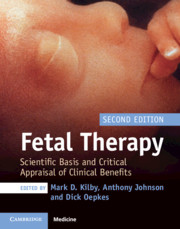Book contents
- Fetal Therapy
- Fetal Therapy
- Copyright page
- Dedication
- Contents
- Contributors
- Foreword
- Section 1: General Principles
- Section 2: Fetal Disease: Pathogenesis and Treatment
- Red Cell Alloimmunization
- Structural Heart Disease in the Fetus
- Fetal Dysrhythmias
- Manipulation of Fetal Amniotic Fluid Volume
- Fetal Infections
- Fetal Growth and Well-being
- Preterm Birth of the Singleton and Multiple Pregnancy
- Chapter 27 The Pathogenesis of Preterm Birth: A Guide to Potential Therapeutic Targets
- Chapter 28 Clinical Interventions for the Prevention and Management of Spontaneous Preterm Birth in the Singleton Fetus
- Chapter 29 Clinical Interventions to Prevent Preterm Birth in Multiple Pregnancies
- Chapter 30 Reducing Neurologic Morbidity from Preterm Birth through Administering Therapy Prior to Delivery
- Complications of Monochorionic Multiple Pregnancy: Twin-to-Twin Transfusion Syndrome
- Complications of Monochorionic Multiple Pregnancy: Fetal Growth Restriction in Monochorionic Twins
- Complications of Monochorionic Multiple Pregnancy: Twin Reversed Arterial Perfusion Sequence
- Complications of Monochorionic Multiple Pregnancy: Multifetal Reduction in Multiple Pregnancy
- Fetal Urinary Tract Obstruction
- Pleural Effusion and Pulmonary Pathology
- Surgical Correction of Neural Tube Anomalies
- Fetal Tumors
- Congenital Diaphragmatic Hernia
- Fetal Stem Cell Transplantation
- Gene Therapy
- Section III: The Future
- Index
- References
Chapter 28 - Clinical Interventions for the Prevention and Management of Spontaneous Preterm Birth in the Singleton Fetus
from Preterm Birth of the Singleton and Multiple Pregnancy
Published online by Cambridge University Press: 21 October 2019
- Fetal Therapy
- Fetal Therapy
- Copyright page
- Dedication
- Contents
- Contributors
- Foreword
- Section 1: General Principles
- Section 2: Fetal Disease: Pathogenesis and Treatment
- Red Cell Alloimmunization
- Structural Heart Disease in the Fetus
- Fetal Dysrhythmias
- Manipulation of Fetal Amniotic Fluid Volume
- Fetal Infections
- Fetal Growth and Well-being
- Preterm Birth of the Singleton and Multiple Pregnancy
- Chapter 27 The Pathogenesis of Preterm Birth: A Guide to Potential Therapeutic Targets
- Chapter 28 Clinical Interventions for the Prevention and Management of Spontaneous Preterm Birth in the Singleton Fetus
- Chapter 29 Clinical Interventions to Prevent Preterm Birth in Multiple Pregnancies
- Chapter 30 Reducing Neurologic Morbidity from Preterm Birth through Administering Therapy Prior to Delivery
- Complications of Monochorionic Multiple Pregnancy: Twin-to-Twin Transfusion Syndrome
- Complications of Monochorionic Multiple Pregnancy: Fetal Growth Restriction in Monochorionic Twins
- Complications of Monochorionic Multiple Pregnancy: Twin Reversed Arterial Perfusion Sequence
- Complications of Monochorionic Multiple Pregnancy: Multifetal Reduction in Multiple Pregnancy
- Fetal Urinary Tract Obstruction
- Pleural Effusion and Pulmonary Pathology
- Surgical Correction of Neural Tube Anomalies
- Fetal Tumors
- Congenital Diaphragmatic Hernia
- Fetal Stem Cell Transplantation
- Gene Therapy
- Section III: The Future
- Index
- References
Summary
Preterm birth, defined as delivery <37 weeks’ gestation, is a major public health issue worldwide. An estimated 15 million babies are born preterm every year [1]. Preterm birth and the associated complications are now the leading cause of mortality in children under the age of 5 worldwide, accounting for 1 million deaths per year [2]. In the US, 11–12% of deliveries occur preterm, and worldwide, this figure is increasing. Babies born at ‘term’ – conventionally designated as 37–42 weeks’ gestation – have consistently better morbidity and mortality outcomes than those born before 37 weeks. In the short term, organ immaturity predisposes the preterm neonate to complications such as intraventricular hemorrhage and periventricular leukomalacia, necrotizing enterocolitis, and respiratory distress syndrome. Immaturity of the immune system increases the risk of neonatal sepsis, meningitis, and pneumonia. In the longer term, preterm babies have an increased prevalence of neurodevelopmental delay and chronic lung disease, and later in life, higher rates of adult-onset disease, from diabetes to hypertension and obesity [3]. Whilst extremely preterm (<28 weeks) and very preterm (28–32 weeks) neonates are at the highest risk of complications, studies have demonstrated that even late preterm birth (34 – 36 + 6 weeks) confers an increased risk of morbidity and mortality [4]. These effects appear to be pervasive, and as such premature infants have been shown to have lower educational attainment and employment than those born at term [5, 6].
- Type
- Chapter
- Information
- Fetal TherapyScientific Basis and Critical Appraisal of Clinical Benefits, pp. 311 - 324Publisher: Cambridge University PressPrint publication year: 2020
References
- 1
- Cited by

